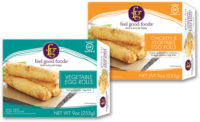Clean-label is one of the top concerns of snack and bakery product development today, in both foodservice and retail markets.
Last year, Panera Bread became the first national restaurant chain to publish a list of all the ingredients it has removed—or plans to remove—from its menu. The collection, called the “No No List,” includes more than 150 additives, sweeteners, colors, flavors and preservatives.
Whole Foods Market has a similar listing on its website of ingredients the retailer finds “unacceptable in food.” The retailer won’t carry items that contain any of the approximately 80 listed ingredients.
These lists, and others of similar ilk, are growing and evolving all the time. Why?
“Clean-label is no longer a novelty,” says Jeff Billig, vice president and general manager, Delavau Food Partners, Philadelphia. “Consumers are expecting familiar ingredients from the foods they buy, whether at the grocery store or a favorite lunch spot. As bloggers and social conversations continue to field mainstream reporting on food, ingredients can become the target of consumer skepticism, merited or not.”
And therein lies the rub with the clean-label trend: Since “clean-label” is not a regulated term, the definition is something of a shapeshifter, evolving constantly, based on who’s asked.
Perhaps Brian Sethness, senior account executive at Sethness Caramel Color, Skokie, IL, puts it best, “There certainly is much more confusion than consensus.”
Subjective familiarity
In lieu of any legal definitions, brands and suppliers are stepping up to offer their own definitions of clean-label, based on what their customers and consumers want. Though they all share some common threads—simple ingredients, shorter ingredient lists, transparency—each of these definitions is subjective and, therefore, flexible.
According to Abby Ceule, director of market management, breads, Corbion Caravan, Lenexa, KS, the company’s research found that label-conscious consumers fall into one of three segments: nutrition-focused (46 percent), ingredient-focused (32 percent) or less engaged in labeling information (22 percent, defined as those who are more impacted by price and may skip reading the ingredient list or nutrition panel altogether).
“Nutrition-focused consumers place more importance on general health and diet factors, are more likely to look at the first few ingredients on the label and focus more on the nutritional panel,” Ceule explains. “Ingredient-focused consumers will place more importance on specific ingredients and are more likely to read the entire ingredients list.”
While nutrition still leads the way, the importance of ingredients is not far behind. “Are the consumers concerned about preservatives or more chemical-sounding ingredients,” asks Ceule, “or is their concern about ingredients that impact the nutritional label, like fat, sugar or salt?” She also notes that “free from” claims carry weight with both of these consumer sets.
Research from Ingredion, Westchester, IL, found that nearly three-quarters of U.S. consumers find it important to be able to recognize the ingredients in the products they buy. “Some general traits that consumers look for are minimally processed foods with more wholesome, authentic and real ingredients; no synthetic additives; and no unexpected allergens, hormones or antibiotics,” explains Angelina De Castro, senior marketing manager at the company’s Wholesome Springboard division. That’s why Ingredion’s definition of clean-label includes simple ingredient listings that consumers can understand, no chemical additives and foods processed using traditional or minimally processed techniques.
For many consumers, the process of better understanding the composition of their food is ongoing. “Many definitions of clean-label are being circulated throughout the food and beverage industry,” says Amy Lauer, North American marketing manager, Tate & Lyle, Hoffman Estates, IL. “We are seeing consumers become more interested in learning about the quality and nutritional benefits of their food. So, to us, clean-label means ingredients that consumers understand and recognize.”
At La Brea Bakery, Los Angeles, clean-label means no artificial flavors or ingredients—things consumers “could find in their grandmother’s kitchen,” Kristina Dermody, president, ARYZTA, owner of the La Brea Bakery brand. “At La Brea Bakery, a ‘simpler label’ means using the purest, most responsibly sourced ingredients that we can use.” That’s why the company’s entire bread portfolio will soon be non-GMO.
Clean and functional
This paradigm shift to clean-label poses numerous challenges to snack producers and bakers. “Shoppers continue to seek familiar ingredients and, for the food industry, that translates to displacing ingredients that come under scrutiny or taking proactive measures to simplify ingredient legends,” says Billig. “While ‘clean-label’ can translate to familiar ingredients, what’s familiar to one person may not be familiar to another. The definition of the term is constantly evolving.”
Ingredion suggests that its new line of pulse-based ingredients meets clean-label criteria, including the VITESSENCE pulse-based protein line derived from pea, lentil and fava bean; HOMECRAFT pulse-based flours, including products derived from pea, lentil, chickpea and fava bean; and ENLITEN reb A stevia, containing more than 95 percent reb A, providing a clean-label, stable sugar alternative that is 200 to 300 times sweeter than sugar.
Minimal processing is a hallmark of Sethness Caramel Color’s Class 1 Caramel Colors, since they carry the European designation of E150a and don’t include ammonium or sulfite compounds. “No matter which class of caramel colors is used, the finished product simply labels ‘caramel color’ on the label,” Sethness points out. “That being said, even though the world’s largest retailer of natural foods states that caramel color is acceptable as a natural color, they prefer Class 1 offerings.”
Tate & Lyle’s CLARIA functional clean-label starches, released in late 2014, enable bakers and snack manufacturers to formulate with functionality similar to modified food starch. Most recently, the company released PromOat Beta Glucan, a natural fiber made from non-GMO Swedish oats.
Understanding and recognizing ingredients is also something that Catherine Barry, director of marketing, National Honey Board, Firestone, CO, notices among consumers. “And they want fewer ingredients in their products, which is why we see so many bakers and snack food manufacturers using honey,” she says. “It’s an exceptional all-natural sweetener that has positive perception with consumers.” She notes that honey plays countless functional roles, as well, including improving humectancy, aiding the Maillard reaction and enhancing flavor, among many others.
The future of clean-label
By its very nature, the clean-label trend will continue to evolve. Going forward, Dermody predicts there will be growing demand for transparency. And because each person’s definition of clean-label is different, transparency allows consumers to make that call for themselves.
Non-GMO will step even further into the spotlight, as a Vermont law mandating that foods made with genetically engineered products be labeled as such is slated to go into effect this July. “Companies selling products in that state may soon have to change their labels,” says Sethness. “We expect the growth of non-GMO ingredients to continue to grow as companies reformulate their products to avoid having to change their labels.”
Dave Dzisiak, commercial lead, grains and oils, Dow AgroSciences, Indianapolis, sees clean label as a generational issue—appealing to millennials—rather than a trend issue. Therefore, brands that embrace clean-label will only see continued success.
“People love snacking, and by 2020, the workforce will be about half millennials, who have a greater willingness to vote with their pocketbook and be a bit more conscious of how they spend their money and why,” says Dzisiak . “As we broaden the supply of these ingredients, the food industry will only have more opportunity. I think this will be a powerful, glacial trend in how food is made and grown, and most importantly, a greater understanding about it.”








